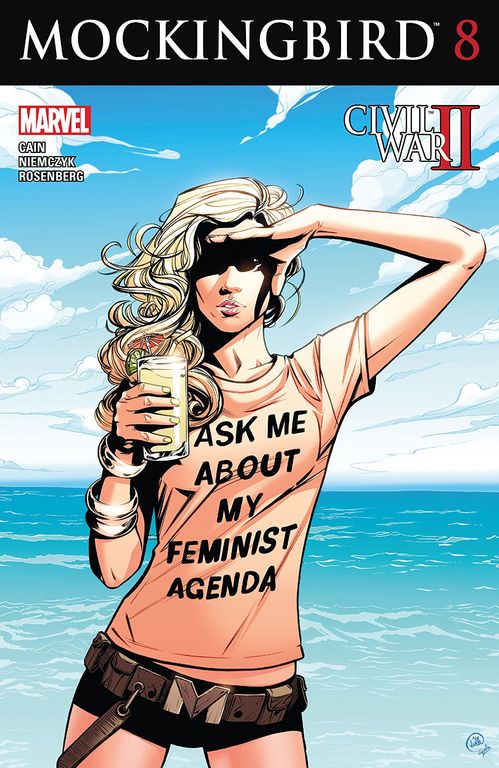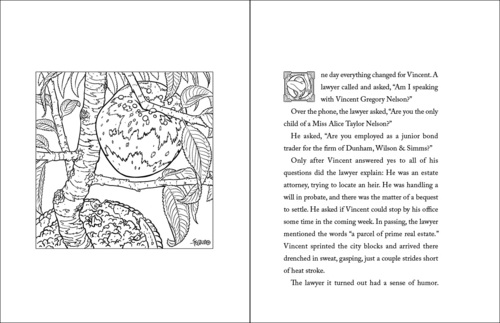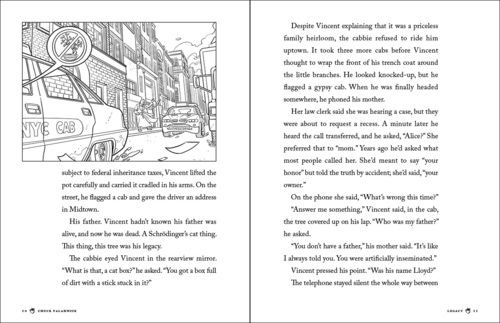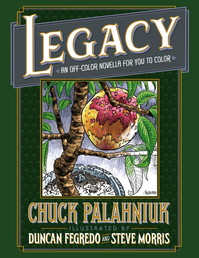Fainting, Sequential Art & Strippers: Chuck Palahniuk and Chelsea Cain in Conversation
Chuck Palahniuk portrait by Alan Amato Comics Features Chuck Palahniuk
Writers Chuck Palahniuk and Chelsea Cain transitioned into illustrated storytelling in the same period, with Palahniuk releasing the comic sequel to Fight Club in May 2015 and Cain launching her first Mockingbird story in September 2015. Both projects became massive, controversial successes. Palahniuk and artist Cameron Stewart amplified the source material’s biting, anti-consumerist exploration of masculinity into a century-spanning, meta mindfuck. Likewise, Cain and artists Joelle Jones and Kate Niemczyk constructed a svelte, intelligent series of interlocking vignettes about a character most often shoehorned as a crazy ex, including a page of paper dolls in each issue. Fight Club 2 served as a bold ambassador for sequential art, attracting fans of the novel and its film translation into its coffee-stained, pill-littered panels. Cain’s debut series invited serious conversation about the growing diversity of comic audiences, a development that saw a misogynistic segment of fandom antagonize Cain on social media, ultimately showing the need for growth in the medium and creating a legendary t-shirt.
The pair’s joint entry into comics isn’t a coincidence, though; both scribes have spent years in the same writing workshop, sipping wine and giving feedback among other Portland area-based peers. Palahniuk tweaked Fight Club 2 for months with Cain and a gaggle of other comic professionals before publisher Dark Horse sent it to the printing press. This week, Palahniuk releases Legacy, an adult coloring book about a man who receives a mysterious gift that reconnects him to his father. Illustrated by Steve Morris and Mike Norton, the work follows last year’s Bait, another Dark Horse-published coloring book that offered readers the chance to stain illustrations standing alongside the author’s provocative, socially scathing prose.
Cain and Palahniuk both hopped on the phone for a flowing chat about the process of segueing from prose to hybrid storytelling, how they workshop and the magic of stripper bingo. ![]()
Paste: Ms. Cain, I know you didn’t have a great scenario in comics, but you both segued into the world of illustrated storytelling at relatively the same time. What were the hurdles and the delights that you didn’t see coming?
Chuck Palahniuk: I thought she had a great debut. She started the turn. She made some noise. I think that’s more important than making a nice, safe status quo intro.
Chelsea Cain: I agree. I think it’s funny, because many people will say to me, I’m so sorry about Mockingbird. And I’m like, What!? really!? I’m not. That book was nominated for two Eisners. It was a bestseller. That was, ultimately, a great experience and one that I still feel is resonating and is creating conversation, and that is a huge victory.
Paste: I think the apology doesn’t regard your work, but your exposure to the dour sides of fandom.
Cain: Mmmhmmm. And those people should apologize.
Like you said, we started out at the same time, and in fact Chuck beat me to it by a year because I really wanted to write a comic book, but I wasn’t ready so I talked him into writing a comic book to test the waters. He was my guinea pig, and it worked great. He was my canary in the coal mine.
Palahniuk: She and Matt Fraction also read my first script for Fight Club 2 and they taught me how to write for comics, so she’s not giving herself enough credit.

Mockingbird Cover Art by Joelle Jones
Paste: How do you approach the storytelling between a comic book and a coloring book? How do you tweak that equation?
Palahniuk: I created the story first and I don’t dictate what the illustrations show, but the artists ask for what I consider to be the high plot points, what should be illustrated with a full page or a partial page. And then they choose from those plot points and they suggest the elements to fill up the page and create as many coloring opportunities as possible. That’s why every wall has a busy wallpaper and every upholstery has some strange tapestry.
Cain: Chuck’s aesthetic in real life is very modern [laughs] and very…Nordic.
Palahniuk: White on white.
Cain: How many plot points or object ideas would you send per story?
Palahniuk: I would send around 16, and then [editor] Scott [Allie] would augment. Sixteen illustrations for a story is a lot. And Scott would send his choices as well. Once we saw what the artist would be working on we’d raise the ante and ask for something even more outrageous, more threatening.
Cain: How detailed a concept? Would it just be a pickle in a hot tub? Would it be simpler or more complex than that? Is it key words or prompts?

Legacy Interior Art by Steve Morris
Palahniuk: It’s usually the moment of a reveal. As a child reading children’s books, you want that visual moment of a reveal with a lot of stuff going on, so you can pour over the whole page and get absorbed in it. But the other thing is to have a very small, partial page illustration, that’s just a pattern—a scarf floating through space. Something that doesn’t have a border around it, but it’s just an object mentioned in the story, but an object with a lot of visual appeal to it.
Cain: When you went through that process of coming up with those images? Did they come to you quickly? Consistently? Or were there some stories that were a little more challenging?
Palahniuk: The way that I write with minimalism, the objects become so important, and repetitive, and they’re key to the plot. And they tend to morph in their meaning throughout the whole story whenever they’re reintroduced. So isolating the objects tends to be very easy.
Cain: Do you worry about tipping your hand with having a visual of the object? Because I know your work with object is so important. Sometimes they can accrue meaning throughout.
Palahniuk: We never show the object until after it’s mentioned in the story. The illustration never precludes what’s about to happen in the story. It’s always a confirmation. Beyond that, no, not really. If anything, we want the illustration to do more—to inform the story in the way that music informs a movie. It adds that extra layer of meaning.
Like the colorists in comics…like [Fight Club 2 colorist] Dave Stewart would bring such a meaning to whatever he was coloring. He had a palette for each reality.
Cain: With comic visuals, the visuals do so much work. They’ll accomplish beats that we can’t do in prose or we’re cheating not to do because the visual does that work. With a coloring book, the images are just supporting. There’s no visual reveal that you wouldn’t get from the words, right?
Palahniuk: Sometimes we do. We add that little extra element of plot in illustration.
Cain: I love that.
Palahniuk: In Bait, the title story Bait ends with a final page turn, when you see that the fish in the fish bowl has got her gun. The fish has killed the villain in the story. And that’s done just with the illustration.
Cain: That’s great.
Paste: With your collective comics experience, is there now a greater tendency to gravitate toward collaborative illustration work now?
Cain: I would definitely like to do more comics. I have some in the works. I really love it, even beyond the collaborative aspect, which is huge for people like the two of us, because we usually spend much of our time alone in a room. Beyond that, I’m very much a visual thinker. I love what can be done in comics in terms of storytelling that cannot be done in prose. There are these brand new tools and brand new story devices that I get to explore. It’s also the first thing that I’ve written that my 12-year-old daughter can read. That also is a plus.

Legacy Interior Art by Steve Morris
Paste: How about you Chuck? I know you have a novel around the corner, but is there still a hook in you to pursue another comic or picture book?
Palahniuk: We tentatively have a plan to put out a coloring book toward the Christmas season every year, for as long as I can create enough stories. There might be a lag this next year because putting together a collection of short stories takes a lot of time. I mean, that’s decades-worths of time. So it might not happen next year, but it will definitely happen in the future.
Paste: Chelsea, you had mentioned that you mostly work alone, but correct me if I’m wrong, but don’t you both have a group where you offer feedback? Tell me about how you creatively work through a project with each other.
Cain: I’m taking a couple of months off from our writing group, so I can’t speak to the last couple of months, but the writing group has been going on for 13…12 years. Longer for everybody, but I have been in the group that long. That’s a long fucking time. We meet once a week for three hours or so. In terms of process, it’s the dangerous writer’s model, which was started by Tom Spanbauer here in Portland. He’s a bit of a writing guru and Chuck studied with him for many years back in the day. Tom’s approach is to have people around the table bring in work, and you have a chapter, maybe 10 pages. I would have enough copies for everyone around the table and pass it out. Everyone would have it in front of them with a writing implement and I would read the chapter aloud. And as I read, the five to eight people in the room, not a big crowd, they take notes on their copies. And then when we’re done, everybody writes some final ideas down on the back, or maybe goes back through it one more time. Then we go around the room and discuss. As we talk about it, I take notes on my master copy, anything that resonates. I collect all of the work, then I have everybody’s notes and I work through and think about them, and look at what different people have to say about different issues. When we do long work, often we will just read aloud a whole book sometimes, just chapter by chapter. It’s a great group, because everybody does lots of different work and has different strengths.
In terms of feedback, it really ranges. We have all been together so long that we can anticipate the kinds of feedback that we’re going to get. Other people have different wheelhouses that they’re good at. It can be broad ideas down to tiny line edits.
Paste: Did you workshop Legacy?
Palahniuk: The original concept of Legacy—a man inheriting a bonsai tree, first thinking that it’s land, then finding out that it’s this tree, then finding out it’s this tree that’s worth millions of dollars, and then finding out it’s the legacy from the father he never knew—so it’s this constantly warping object. I brought in the original premise and presented it.
Cain: It was like a short story, right?
Palahniuk: It was a short story, and I knew that it was going to turn into something gigantic, like a novella, and novellas aren’t possible to sell. It was also going to be fantasy, and fantasy also made me a little nauseous. It seemed perfect for a coloring book, because it would have a visual of the fantastic, and it would be too long for a short story and too short for a novel. It just seemed perfect for what it is.
I brought in the premise just to see if people would engage with it. But it wasn’t a full anything. It was just an opening few scenes.
Cain: Was that the period when we were trying to write stories with happy endings?
Palahniuk: Yeah! [Laughs] I wrote happy endings.
Cain: He tried. He tried to write stories with happy endings. Very difficult for him. Chuck Palahniuk’s idea for a happy ending is not necessarily the popular one.
Palahniuk: It was the big plot of the missing father, and that was just not something I wanted to process in workshop. I did not want to bring in the chapters where he inquired about who was my father? and really talked to the female character, who knew his father for his entire life. I just didn’t want to bring in something that personal.
Cain: Why? [Laughs]
Palahniuk: When I bring something to workshop, number one I want the visceral reaction, whether they laugh, or they moan. I want the nonverbal, emotional response to what occurs in the moment whenever a scene is read: whether a scene works and whether people engage with it. Another level, I bring it in to see where it doesn’t work. Where even as I’m reading it, I am bored. I know that that scene is not working, and it’s going too long. Regardless of what people say afterwards, I think the most important feedback occurs in the act of reading the book aloud and the act of listening as people hear it for the first time. For me, that’s the most important aspect of reading to a peer group.
Cain: I will tell you something about Chuck Palahniuk, and that is that Chuck has a very unique skill of reading the emotional intensity of a room. It makes his events so spectacular, because he can really read a crowd in an almost Trumpian sense [laughs]. It’s interesting, because I think you do that like a maestro in a way that I don’t think you are as good at one on one. It accrues and stacks. If you have a sampling—even just three people—you can read that. Somehow it glows. You can really feel how the story works, in a way not everyone can. So it’s interesting to hear you say that that’s what’s most helpful.

Legacy Interior Art by Steve Morris
Paste: About 15 years ago, I heard you talk, Chuck, and I didn’t pass out, but I could see where people would. I haven’t been able to wrap my head around that. Has there been any explanation for your power to wield people to those emotional extremes?
Cain: I have some theories. [laughs]
Palahniuk: In the “Guts” story in particular, which makes people faint so often, a doctor in England was at an event in Cambridge where several people passed out. He said that there’s something that people do at Church services, these kind of evangelical church services where they have everyone singing and chanting and they get them hyperventilating so that their blood is alkaline rather than acid-based. Then they create a shot—something happens. At that point, they’re physiologically set up to pass out. So the fact that “Guts” makes people pass out so much in the first half…it’s basically one dark laugh line after another, without really revealing where the story’s going to go. And then it forces the listener to realize what’s happening while the narrator thinks that it’s some kind of snake hiding in their swimming pool. And the reader gets the realization without being told. At that point, they laugh so much, like at a church service, it sets them up to pass out. That’s how he explained it to me, and he went into a lot of mechanical detail about how their head flops, and then in order to open their airway they subconsciously lift their head and fall to the floor. Wonderful, gruesome details.
Cain: Chuck also releases chloroform. [Laughs]
Palahniuk: You’ve been to events where I’ve read the story.
Cain: I have. I’ve seen it with my own eyes. That event in New Orleans…it was very crowded. People had been drinking and they were so excited. I think that it all works together. I think that’s actually quite plausible, the hyperventilating. It’s a blood-pressure issue. It seems like when one person goes, it triggers people who are right on the edge into dropping.
Paste: What was your feedback for Legacy when you were workshopping it?
Palahniuk: For Legacy, I just brought in the first few scenes and there wasn’t a lot for people to work with. It was just a guy inheriting a tree and going to a strip bar, and not much more than that. It was only the first six or seven pages. I don’t remember a lot of feedback.
Cain: It really was just a concept, which Chuck will do a lot, because he has a lot of ideas and a lot of concepts that he’ll bring in. Just something—a situation, to see how it drops, how evocative it is, if it resonates emotionally…all of that stuff. If we’re intrigued or we’re not, and if he finds that there’s something more to it, then he’ll take it away and do something with it.
Palahniuk: So often, it’s that technique that I call crowd seating, where a good story will evoke similar stories from the audience. Someone will almost always step forward and say, “Something almost exactly like that happened to me.” They’ll offer better examples of what you’re demonstrating than what you just offered.
Cain: Then Chuck just uses those.
Palahniuk: Exactly. [Laughs] It’s a way of saying this is the kind of story I’m looking for, these are the themes worth exploring, and then sort of gleaning those from enormous numbers of listeners.
Cain: One of my favorite workshop activities, one of the most fun and productive, was for Rant. We were all brainstorming ideas that people would have on top of their cars. That was so fun. That type of thing—what people haul on top of their cars.
Palahniuk: This is another aspect of workshop, for Rant in particular. I had no idea about putting in the little suns and the little moons to denote whether people lived during the daytime or the nighttime. Chelsea was the one who said, “Why don’t you put in a little sun or a little moon?” People’s response to that was so strong. They loved that. Also in my book Pygmy, Chelsea was the one who said…is it called redactedness? Where you blank out certain clauses on the first page of each chapter, give it that censored FBI file look. Both of these are very visual ideas that would not have occurred to me.
Cain: I came up with that twist in Fight Club, too. A lot of people don’t know that. [Laughs] That’s how rumors get started…
Paste: Per the visual elements of your work, how involved are you in picking your collaborators?
Cain: Very, very involved. With Mockingbird, Marvel sent me ideas and lookbooks. I rejected a few people and we came across Kate [Niemczyk] and I really liked her work.
Palahniuk: What was the book you did with Joelle Jones?
Cain: That was the first Mockingbird, which was a standalone. Joelle then works on the covers.
Palahniuk: What a treat, because she is impossible to get. I was so thrilled that she would do one story for Bait.

Legacy Interior Art by Steve Morris
Paste: What appealed to you about Mike Norton and Steve Morris, Chuck?
Palahniuk: Well originally [cover artist] Duncan [Fegredo] was supposed to do the entire book. And then Duncan had to have eye surgeries, so it was easy to complain about not getting Duncan, and at the same time be concerned that Duncan might have damaged eyesight. It was terrifying. But both the other two had done work for Bait that I really liked, so it was very easy to segue to them.
Paste: Chelsea, is any of your DNA in Legacy from the feedback you offered?
Cain: Jeeze, I’m sure it is: yes. I don’t know, honestly. Is it, Chuck?
Palahniuk: I don’t know. I’d have to think.
Cain: All the really clever parts….
Palahniuk: It just seemed like such a story…I didn’t know what to do with it or place it, so I just quit bringing it to workshop. I didn’t finish it till this last winter.
Cain: I didn’t see anything beyond the original concept that he brought in.
Palahniuk: It’s funny, because Scott [Allie] calls it the most spiritual story that I’ve ever written. Maybe that’s why I couldn’t bring it in. A lot of times, I swear to God, I have to take Ativan before I read a story at a public event, because the stories are about some unexpressed part of me. Suddenly, they’re being expressed in front of hundreds of people. I have to make sure that the emotion lands out in the auditorium, and that the emotion isn’t going to happen on the stage. So, in a way, I just have to shut down my emotions in order to present these stories. I wouldn’t write them unless they came from some place really unresolved.
Paste: Why did you select fatherhood as the central topic in Legacy?
Palahniuk: Well, my father never knew his father, because his father had committed a murder/suicide when my father was three of four years old. My father’s earliest memories are of hiding from his father, as his father had killed his mother, and is looking to kill my father, his son. So my father in a way spent his entire life moving from one relationship to another, always looking for his mother. Eventually, he himself was killed by a man with a gun. All of those were such an unresolved pattern…
Cain: And your relationship to him…
Palahniuk: I don’t know…this sounds so skeezy, but my father would never talk about himself. And I always found that the best way to find out about my father was to talk to his ex-wives. He would tell women things that he would not tell his sons. So in a way, I would interview each of the women he had been married to, and they would tell me things about his childhood that I had no idea about. It sounds skeezy and kind of backdoor, to talk to them about these things, but I’d rather find out about them anyway than never know them.
Cain: That would be a great book: somebody’s life just told from the point of view of the women.
Palahniuk: Go for it. [Laughs] I can’t write that stuff! I can’t write anything honest and real! There’s too much honest and real out there.
Paste: You’ve both been in Portland for more than a decade and part of Legacy takes place in a strip club. It seems like strip cubs are a different sociological institution in Portland.
Cain: We have to have one of the only vegan strip clubs, right?
Palahniuk: Vegan and pirate strip clubs.
Cain: That was close. [Laughs]
Palahniuk: It’s a tough marketing niche. [Legacy takes place in a strip club] because it’s part of Cacophony society. So many of our events would take place at strip clubs, or they would pass through a strip club as a station of the cross. The Santas in Santa Rampage would always end up downtown at Mary’s or some other skeezy strip club. And then there were events like stripper bingo, where you’d get bingo cards, and when the stripper would do a certain move, you’d be able to black out that spot on your card until somebody had stripper bingo.
Cain: This is such an activity for gay men. [laughs]
Palahniuk: Cacophony was at least equally men and women. And in a way it took this sordid situation and turned it into a childhood activity.
Cain: Like a baby shower activity.
Palahniuk: Exactly. And the strippers loved it, because Cacophony tipped like crazy. It was such a fun, experiential grassroots thing. And it really was the basis of Burning Man. It was about creating these participatory games and little existentialist pranks. We’re not really political in nature. They were just about being out in the world and performing for one another. And also hosting things for one another. They were so much more fun because they weren’t about fixing anything.
